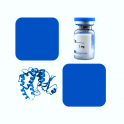
- Remove this product from my favorite's list.
- Add this product to my list of favorites.
Products
Viewed products
Newsletter
 |  |  |  |  |  |

Background
4-1BB, also known as CD137, tumor necrosis factor receptor superfamily member 9 (TNFRSF9), induced by lymphocyte activation (ILA), is a co-stimulatory molecule of the tumor necrosis factor (TNF) receptor superfamily. CD137 can be expressed by activated T cells, but to a larger extent on CD8 than on CD4 T cells. In addition, CD137 expression is found on dendritic cells, follicular dendritic cells, natural killer cells, granulocytes and cells of blood vessel walls at sites of inflammation. The best characterized activity of CD137 is its costimulatory activity for activated T cells. Crosslinking of CD137 enhances T cell proliferation, IL-2 secretion survival and cytolytic activity. Further, it can enhance immune activity to eliminate tumors in mice. CD137 can enhance activation-induced T cell apoptosis when triggered by engagement of the TCR/CD3 complex. In addition, 4-1BB/4-1BBL co-stimulatory pathway has been shown to augment secondary CTL responses to several viruses, and meanwhile augment anti-tumor immunity. 4-1BB thus is a promising candidate for immunotherapy of human cancer. CD137 has been shown to interact with TRAF2.
Source
Recombinant Human 4-1BB, His Tag (41B-H52Hc) is expressed from human 293 cells (HEK293). It contains AA Leu 24 - Gln 186 (Accession # Q07011-1).
Predicted N-terminus: Leu 24
Molecular Characterization
This protein carries a polyhistidine tag at the C-terminus.
The protein has a calculated MW of 19.2 kDa. The protein migrates as 27-35 kDa when calibrated against Star Ribbon Pre-stained Protein Marker under reducing (R) condition (SDS-PAGE) due to glycosylation.
Endotoxin
Less than 1.0 EU per μg by the LAL method.
Purity
>90% as determined by SDS-PAGE.
Formulation
Lyophilized from 0.22 μm filtered solution in PBS, pH7.4 with trehalose as protectant.
Reconstitution
Please see Certificate of Analysis for specific instructions.
For best performance, we strongly recommend you to follow the reconstitution protocol provided in the CoA.
Storage
For long term storage, the product should be stored at lyophilized state at -20°C or lower.
Please avoid repeated freeze-thaw cycles.
This product is stable after storage at:
-20°C to -70°C for 12 months in lyophilized state;
-70°C for 3 months under sterile conditions after reconstitution.
Bioactivity
Please refer to product data sheet.
(1) "Preclinical characterization and phase 1 results of ADG106 in patients with advanced solid tumors and non-Hodgkin's lymphoma"
Ma, Luo, Zhang et al
Cell Rep Med (2024)
(2) "Efficacy and safety of autologous tumor-infiltrating lymphocytes in recurrent or refractory ovarian cancer, colorectal cancer, and pancreatic ductal adenocarcinoma"
Amaria, Knisely, Vining et al
J Immunother Cancer (2024) 12 (2)
(3) "Sustained efficacy of chimeric antigen receptor T-cell therapy in central nervous system lymphoma: a systematic review and meta-analysis of individual data"
Zhou, Wang, Wang et al
Front Pharmacol (2023) 14, 1331844
Showing 1-3 of 1615 papers.
Follow us